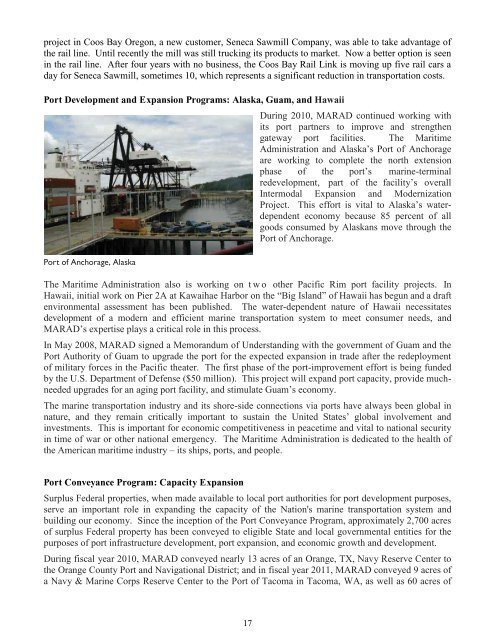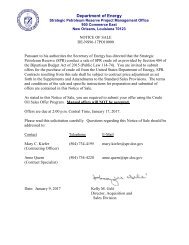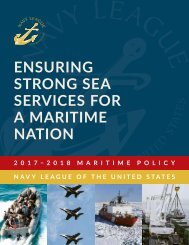2010-11_ANNUAL_REPORTS_-_FINAL_VERSION_(3)
2010-11_ANNUAL_REPORTS_-_FINAL_VERSION_(3)
2010-11_ANNUAL_REPORTS_-_FINAL_VERSION_(3)
Create successful ePaper yourself
Turn your PDF publications into a flip-book with our unique Google optimized e-Paper software.
project in Coos Bay Oregon, a new customer, Seneca Sawmill Company, was able to take advantage of<br />
the rail line. Until recently the mill was still trucking its products to market. Now a better option is seen<br />
in the rail line. After four years with no business, the Coos Bay Rail Link is moving up five rail cars a<br />
day for Seneca Sawmill, sometimes 10, which represents a significant reduction in transportation costs.<br />
Port Development and Expansion Programs: Alaska, Guam, and Hawaii<br />
Port of Anchorage, Alaska<br />
During <strong>2010</strong>, MARAD continued working with<br />
its port partners to improve and strengthen<br />
gateway port facilities. The Maritime<br />
Administration and Alaska’s Port of Anchorage<br />
are working to complete the north extension<br />
phase of the port’s marine-terminal<br />
redevelopment, part of the facility’s overall<br />
Intermodal Expansion and Modernization<br />
Project. This effort is vital to Alaska’s waterdependent<br />
economy because 85 percent of all<br />
goods consumed by Alaskans move through the<br />
Port of Anchorage.<br />
The Maritime Administration also is working on t w o other Pacific Rim port facility projects. In<br />
Hawaii, initial work on Pier 2A at Kawaihae Harbor on the “Big Island” of Hawaii has begun and a draft<br />
environmental assessment has been published. The water-dependent nature of Hawaii necessitates<br />
development of a modern and efficient marine transportation system to meet consumer needs, and<br />
MARAD’s expertise plays a critical role in this process.<br />
In May 2008, MARAD signed a Memorandum of Understanding with the government of Guam and the<br />
Port Authority of Guam to upgrade the port for the expected expansion in trade after the redeployment<br />
of military forces in the Pacific theater. The first phase of the port-improvement effort is being funded<br />
by the U.S. Department of Defense ($50 million). This project will expand port capacity, provide muchneeded<br />
upgrades for an aging port facility, and stimulate Guam’s economy.<br />
The marine transportation industry and its shore-side connections via ports have always been global in<br />
nature, and they remain critically important to sustain the United States’ global involvement and<br />
investments. This is important for economic competitiveness in peacetime and vital to national security<br />
in time of war or other national emergency. The Maritime Administration is dedicated to the health of<br />
the American maritime industry – its ships, ports, and people.<br />
Port Conveyance Program: Capacity Expansion<br />
Surplus Federal properties, when made available to local port authorities for port development purposes,<br />
serve an important role in expanding the capacity of the Nation's marine transportation system and<br />
building our economy. Since the inception of the Port Conveyance Program, approximately 2,700 acres<br />
of surplus Federal property has been conveyed to eligible State and local governmental entities for the<br />
purposes of port infrastructure development, port expansion, and economic growth and development.<br />
During fiscal year <strong>2010</strong>, MARAD conveyed nearly 13 acres of an Orange, TX, Navy Reserve Center to<br />
the Orange County Port and Navigational District; and in fiscal year 20<strong>11</strong>, MARAD conveyed 9 acres of<br />
a Navy & Marine Corps Reserve Center to the Port of Tacoma in Tacoma, WA, as well as 60 acres of<br />
17




